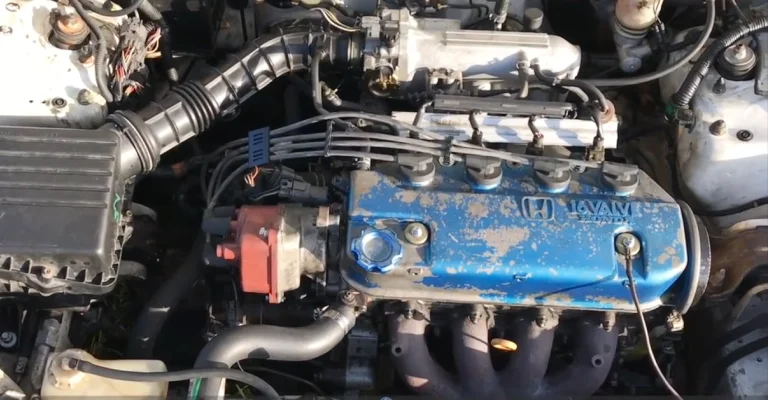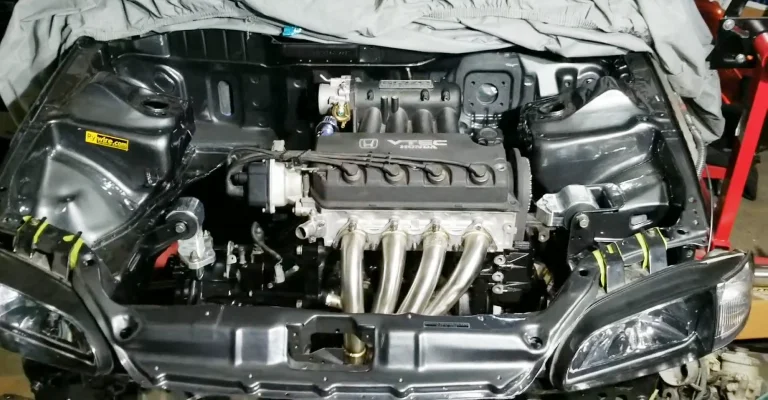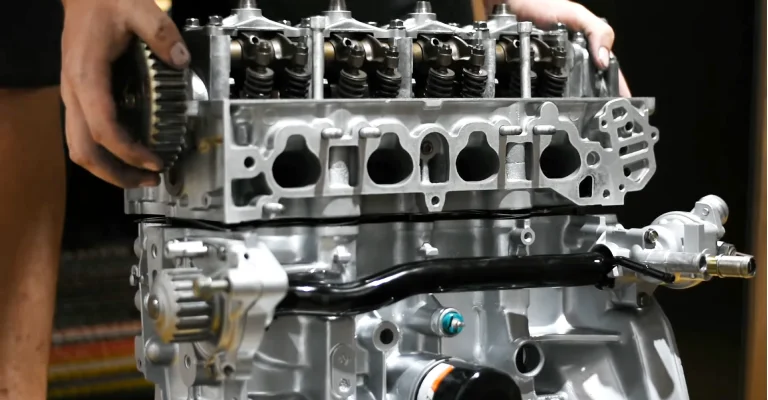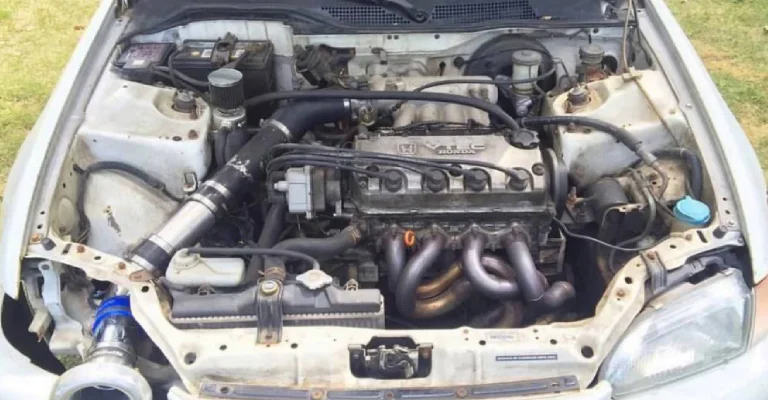The Honda D16Z6 is a 1.6-liter, 4-cylinder engine that was produced by Honda between 1988 and 2000.
It was used in a variety of Honda models, including the Civic, Del Sol, and Integra. The engine was known for its high performance and reliability.

Overview of the Engine’s Specs and Features
The D16Z6 engine has a displacement of 1.6 liters and a compression ratio of 9.2:1. It is equipped with a DOHC (double overhead cam) valvetrain, which allows for increased airflow and horsepower.
The engine also features Honda’s PGM-FI (Programmed Fuel Injection) system, which delivers fuel to the engine in a precise and controlled manner, resulting in improved fuel efficiency and performance.
The D16Z6 engine also has a redline of 8,200 RPM which was considered a high number for an engine of this size.
| Specification | Honda D16Z6 Engine |
|---|---|
| Engine Type | 4-Cylinder, SOHC |
| Displacement | 1.6 Liters |
| Bore x Stroke | 81mm x 77.4mm |
| Compression Ratio | 9.2:1 |
| Power | 125 horsepower @ 6600 RPM |
| Torque | 106 lb-ft @ 5200 RPM |
| Valvetrain | SOHC VTEC |
| Fuel Control | OBD-1 PGM-FI |
| Head Code | P08 |
| ECU Code | P28 |
| Redline | 7200 RPM |
| Fuel Cut | Over 7400 RPM |
| VTEC Switchover | 4800 RPM |
| Volumetric Efficiency | 87.69% |
| Rod Length | 137 mm |
| Rod Ratio | 1.52~ |
Note: This table may not include all the engine’s specifications, it’s just a highlight of the most important ones.
Design and Build of Honda D16Z6 Engine

The engine also has a lightweight aluminum block and head, which helps to reduce overall weight and improve performance.
Discussion of the Engine’s Construction and Materials
The D16Z6 engine was built with a focus on performance and reliability. The engine’s block and head were constructed from aluminum alloy to reduce weight and increase thermal efficiency.
The connecting rods were made of high-strength steel to withstand high-performance use. The engine also featured a cast iron cylinder liner, which helped to increase durability and reduce wear.
Comparison to other Honda engines
The D16Z6 engine was a high-performance variant of Honda’s D-series engine lineup.
Compared to other D-series engines, the D16Z6 featured a higher compression ratio, more advanced valvetrain and improved intake and exhaust systems, resulting in increased horsepower and torque.
It also had a higher redline than other D-series engine variants which made it suitable for high-performance applications. The D16Z6 was considered to be one of the most powerful D-series engines produced by Honda during that time.
Performance Of D16Z6 Engine

The D16Z6 engine has a factory horsepower rating of 125 horsepower and 106 lb-ft of torque.
This made it one of the most powerful engines in its class at the time of its release. The engine’s high-performance design and advanced valvetrain allowed it to produce more horsepower and torque than many of its competitors.
Comparison to other engines in its class:
The D16Z6 engine competed with other 1.6-liter, 4-cylinder engines from other manufacturers during its production run.
Compared to its competitors, the D16Z6 had a higher horsepower and torque output and a higher redline. This made it a popular choice among enthusiasts looking for a high-performance engine.
Analysis of acceleration and top speed
The D16Z6 engine’s high horsepower and torque output, combined with its lightweight construction, made it capable of producing brisk acceleration and high top speeds. This made it a popular choice among Honda enthusiasts and those looking for a sporty driving experience.
Review of the engine’s fuel efficiency
The D16Z6 engine’s fuel efficiency was considered to be good for its class. The engine’s PGM-FI fuel injection system, along with its high compression ratio, helped to improve fuel efficiency by delivering fuel in a precise and controlled manner.
The engine’s high-performance design and advanced valvetrain did not compromise its fuel efficiency.
Additionally, Honda’s reputation for fuel-efficient vehicles made the D16Z6 an attractive option for car buyers looking for a balance of performance and fuel economy.
Reliability and Maintenance

The D16Z6 engine was known for its reliability and durability. Honda’s reputation for building long-lasting engines, along with the engine’s high-quality construction and materials, helped to ensure that the D16Z6 had a long service life.
Analysis of common issues and problems
As with any engine, the D16Z6 is not immune to issues and problems. Some common issues that have been reported include oil leaks, valve seal issues, and worn-out timing belts.
However, these issues are generally considered to be minor and can be easily addressed with regular maintenance and timely repairs.
Additionally, the D16Z6 engine was known for being able to handle high-performance use, so it is not as common to find major issues with it. It is worth noting that any high-performance engine will require more frequent maintenance and should be checked by a professional mechanic.
Overall, the D16Z6 engine is considered to be a reliable and durable engine that is well-suited to high-performance applications. Regular maintenance and timely repairs can help to ensure that the engine continues to perform at its best for many years to come.
Overview of Recommended Maintenance and Service Interval
To ensure the longevity and optimal performance of the D16Z6 engine, it is important to follow the recommended maintenance and service intervals as outlined in the vehicle’s owner’s manual.
This typically includes regular oil changes, air filter replacements, and inspections of the engine’s belts and hoses.
It is recommended to have the timing belt and water pump replaced at regular intervals, usually at 60,000 miles or 96,000 km.
Tips for prolonging the engine’s lifespan
To prolong the lifespan of the D16Z6 engine, it is important to:
- Follow the recommended maintenance and service intervals as outlined in the vehicle’s owner’s manual.
- Use high-quality oil and other fluids that are recommended by the manufacturer.
- Keep the engine at the proper temperature by allowing it to warm up before driving and avoiding excessive idling.
- Avoid overloading the engine by not towing heavy loads or using the vehicle for racing or other high-performance applications.
- Avoid prolonged high-speed driving, instead it’s better to maintain a steady speed.
- Regularly inspect the engine’s belts and hoses for signs of wear or damage.
- Always use the correct octane rating for fuel.
By following these tips, and by taking care of the D16Z6 engine, you can help ensure that it continues to perform at its best for many years to come.
Is The Honda D16 Engine Reliable?
As you know, Honda engines are notorious for their reliability, and the D16 is no exception. It is always important to get regular service and maintenance, especially when it comes to oil changes, but we’ve seen vehicles that are still going strong after more than 180,000 to 200,000 miles of service.
Comparison With Other D16 Family Engines

The D16Z6 engine belongs to the D16 family of engines, which includes several other engine models such as D16A1, D16A3, D16A6, D16A8, D16A9, D16Z5, D16Y4, D16Y5, D16Y7, D16Y8, D16B1, D16B2, D16B3, D16B5, D16B6, D16B7, D16B8, D16W1, D16W2, D16W3, D16W4, D16W5.
Compared to other D16 engines, the D16Z6 is known for its high horsepower and torque output, thanks to its VTEC technology.
The D16Z6 engine produced 125 horsepower and 106 lb-ft of torque. This is more than other D16 engines such as the D16A6, D16A8, D16Y4, D16Y5, D16Y7, and D16Y8, which produced around 100 horsepower.
The D16Z6 also features a higher compression ratio and a higher redline than other D16 engines, which helps to improve its overall performance.
Additionally, the D16Z6 engine is known for its reliability and durability, thanks to its advanced design and technology.
Most Common Problems with D16Z6 Engine
The D16Z6 engine is generally known for being a reliable and durable engine, but there are a few common issues that can arise with it. Some of these issues include:
Timing belt failure
The timing belt is responsible for keeping the camshaft and crankshaft in sync, and if it breaks or slips, it can cause major engine damage. It’s important to replace the timing belt at the recommended intervals to avoid this issue.
Oil pump failure
The oil pump is responsible for circulating oil throughout the engine, and if it fails, the engine can experience a lack of lubrication and seizing.
Head gasket failure
The head gasket seals the combustion chamber and prevents coolant and oil from mixing. If it fails, it can cause coolant to leak into the oil and cause low compression, resulting in a loss of power and possible engine damage.
Valve stem seals
The valve stem seals are responsible for preventing oil from leaking into the combustion chamber. If they fail, it can cause the engine to burn oil and produce blue smoke from the exhaust.
Distributor
The distributor is a mechanical component and it can wear out over time. This can cause misfiring and poor performance of the engine.
It’s worth noting that many of these issues can be caused by poor maintenance or neglect, so it’s important to keep up with regular oil changes and other routine maintenance to keep your D16Z6 engine running smoothly.

Leave a Reply